Financial Decision Making: Ratio Analysis of ALPHA Limited
VerifiedAdded on 2023/06/10
|8
|2033
|101
AI Summary
This report provides a ratio analysis of ALPHA limited to comment on its financial performance from the perspective of potential investors. It includes interpretation and analysis of performance, suggestions for improvement, and references.
Contribute Materials
Your contribution can guide someone’s learning journey. Share your
documents today.

FINANCIAL DECISION
MAKING
MAKING
Secure Best Marks with AI Grader
Need help grading? Try our AI Grader for instant feedback on your assignments.
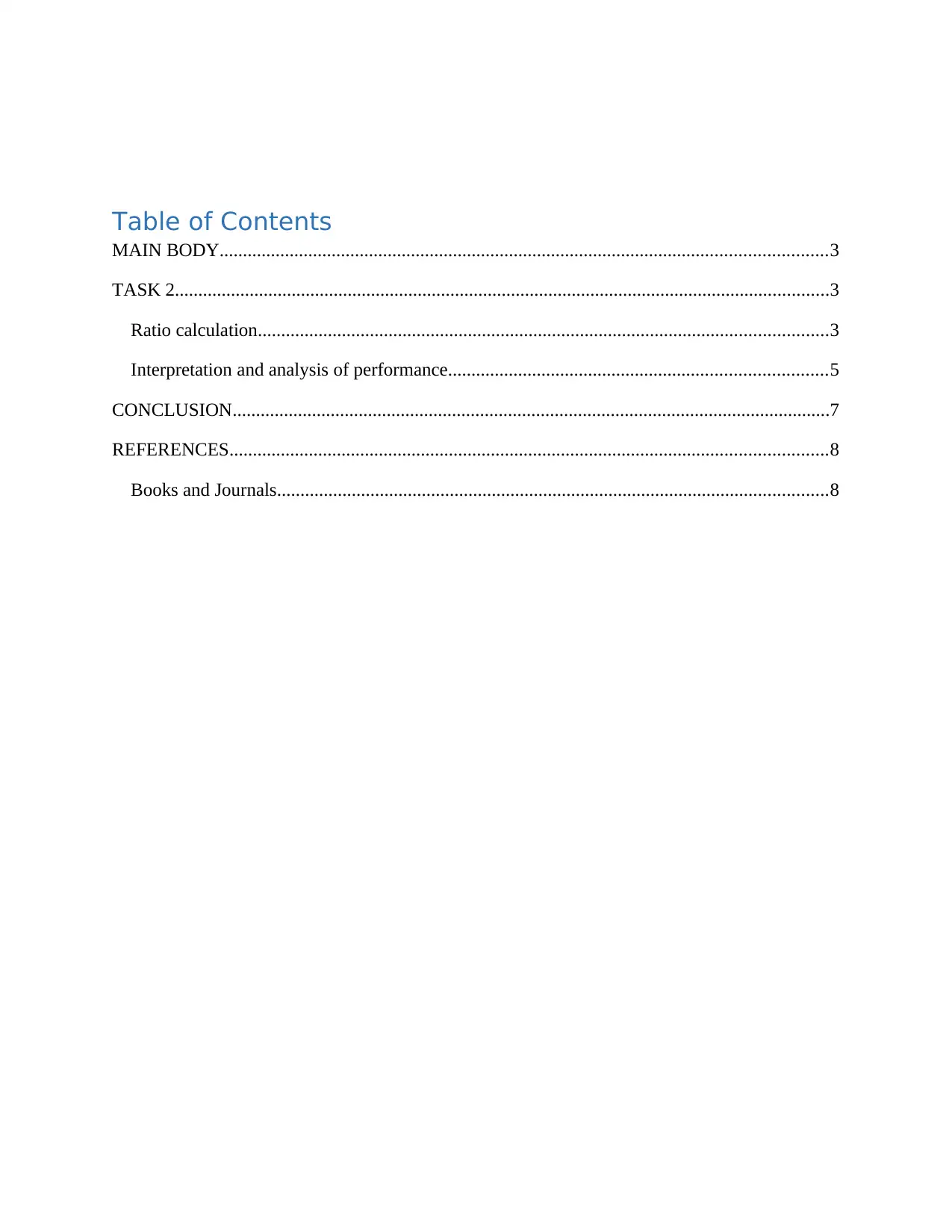
Table of Contents
MAIN BODY..................................................................................................................................3
TASK 2............................................................................................................................................3
Ratio calculation..........................................................................................................................3
Interpretation and analysis of performance.................................................................................5
CONCLUSION................................................................................................................................7
REFERENCES................................................................................................................................8
Books and Journals......................................................................................................................8
MAIN BODY..................................................................................................................................3
TASK 2............................................................................................................................................3
Ratio calculation..........................................................................................................................3
Interpretation and analysis of performance.................................................................................5
CONCLUSION................................................................................................................................7
REFERENCES................................................................................................................................8
Books and Journals......................................................................................................................8
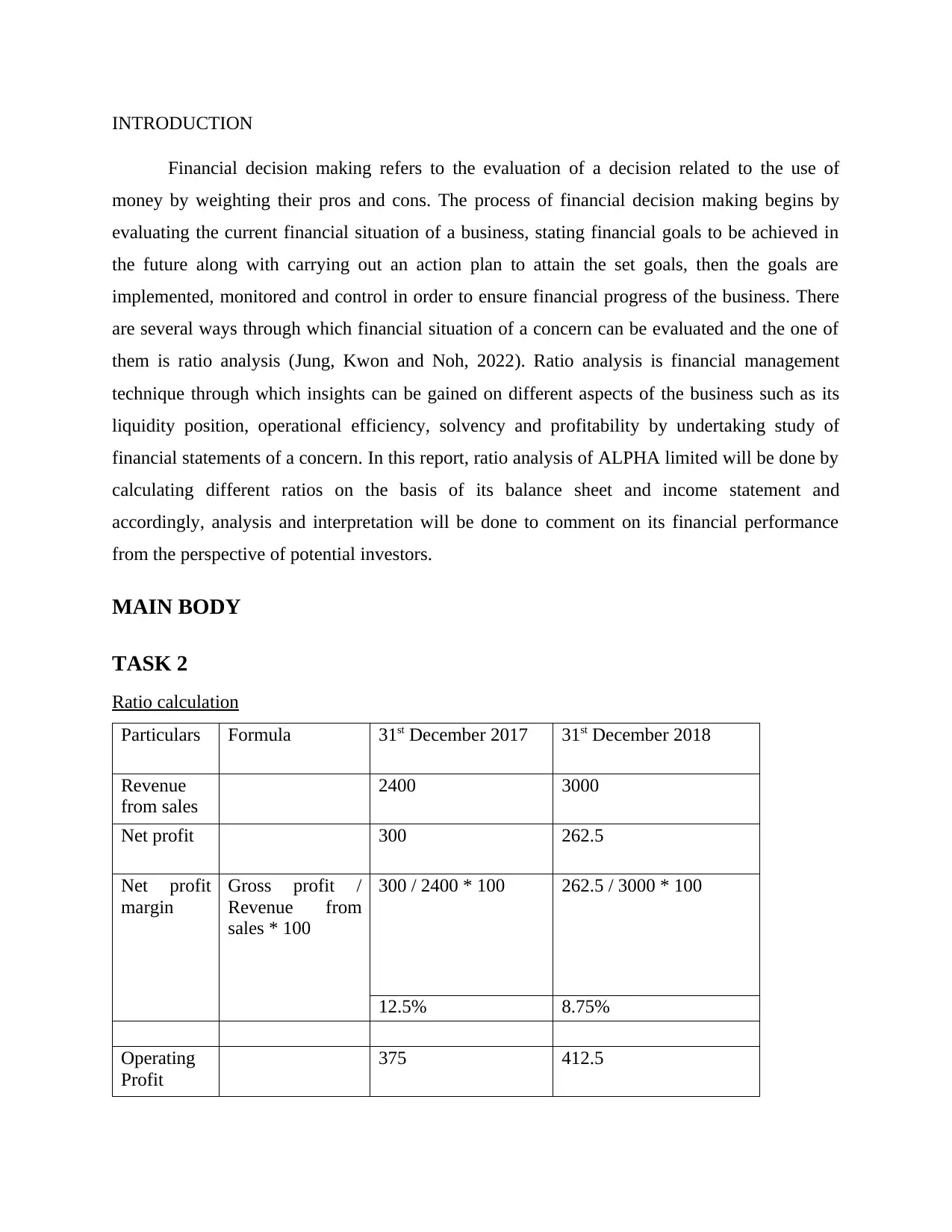
INTRODUCTION
Financial decision making refers to the evaluation of a decision related to the use of
money by weighting their pros and cons. The process of financial decision making begins by
evaluating the current financial situation of a business, stating financial goals to be achieved in
the future along with carrying out an action plan to attain the set goals, then the goals are
implemented, monitored and control in order to ensure financial progress of the business. There
are several ways through which financial situation of a concern can be evaluated and the one of
them is ratio analysis (Jung, Kwon and Noh, 2022). Ratio analysis is financial management
technique through which insights can be gained on different aspects of the business such as its
liquidity position, operational efficiency, solvency and profitability by undertaking study of
financial statements of a concern. In this report, ratio analysis of ALPHA limited will be done by
calculating different ratios on the basis of its balance sheet and income statement and
accordingly, analysis and interpretation will be done to comment on its financial performance
from the perspective of potential investors.
MAIN BODY
TASK 2
Ratio calculation
Particulars Formula 31st December 2017 31st December 2018
Revenue
from sales
2400 3000
Net profit 300 262.5
Net profit
margin
Gross profit /
Revenue from
sales * 100
300 / 2400 * 100 262.5 / 3000 * 100
12.5% 8.75%
Operating
Profit
375 412.5
Financial decision making refers to the evaluation of a decision related to the use of
money by weighting their pros and cons. The process of financial decision making begins by
evaluating the current financial situation of a business, stating financial goals to be achieved in
the future along with carrying out an action plan to attain the set goals, then the goals are
implemented, monitored and control in order to ensure financial progress of the business. There
are several ways through which financial situation of a concern can be evaluated and the one of
them is ratio analysis (Jung, Kwon and Noh, 2022). Ratio analysis is financial management
technique through which insights can be gained on different aspects of the business such as its
liquidity position, operational efficiency, solvency and profitability by undertaking study of
financial statements of a concern. In this report, ratio analysis of ALPHA limited will be done by
calculating different ratios on the basis of its balance sheet and income statement and
accordingly, analysis and interpretation will be done to comment on its financial performance
from the perspective of potential investors.
MAIN BODY
TASK 2
Ratio calculation
Particulars Formula 31st December 2017 31st December 2018
Revenue
from sales
2400 3000
Net profit 300 262.5
Net profit
margin
Gross profit /
Revenue from
sales * 100
300 / 2400 * 100 262.5 / 3000 * 100
12.5% 8.75%
Operating
Profit
375 412.5
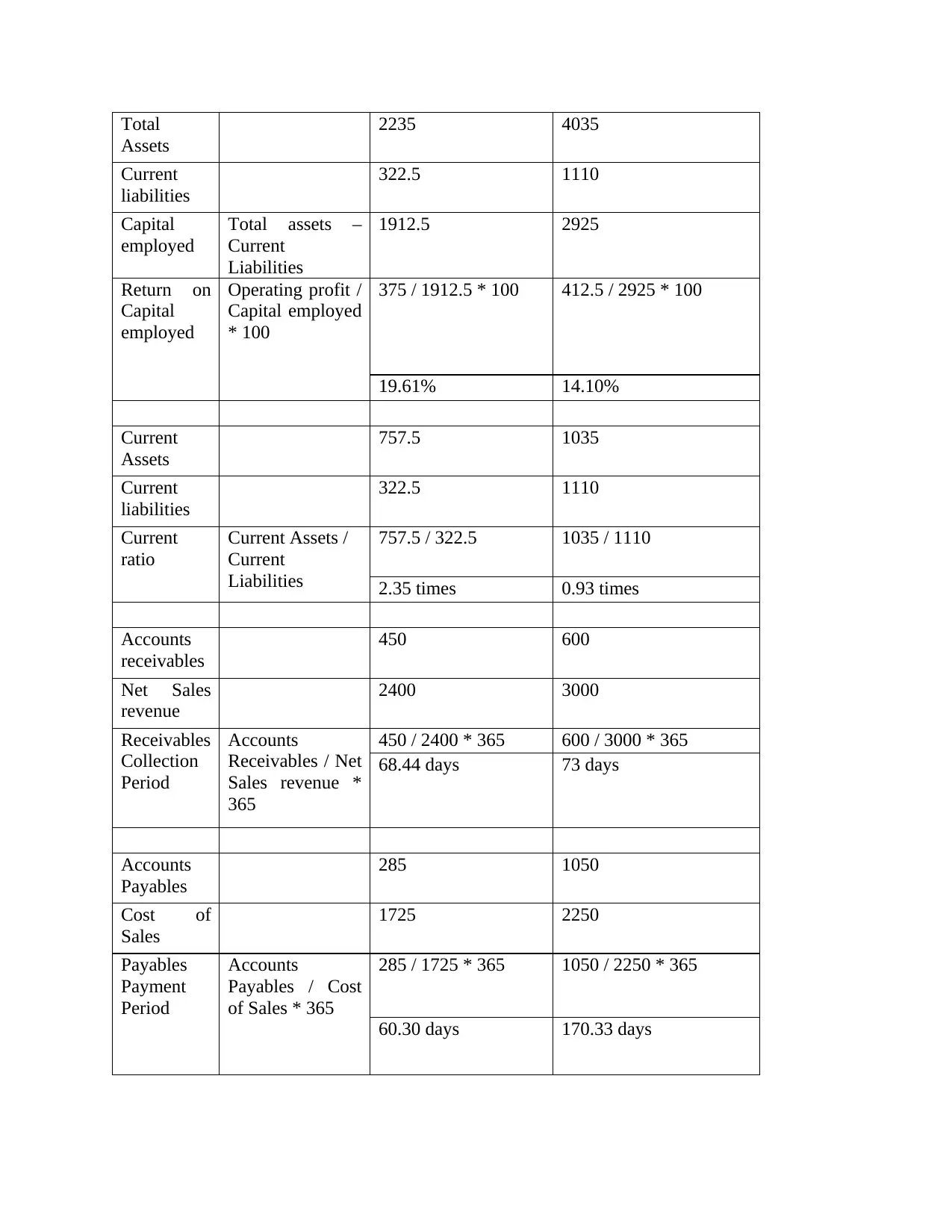
Total
Assets
2235 4035
Current
liabilities
322.5 1110
Capital
employed
Total assets –
Current
Liabilities
1912.5 2925
Return on
Capital
employed
Operating profit /
Capital employed
* 100
375 / 1912.5 * 100 412.5 / 2925 * 100
19.61% 14.10%
Current
Assets
757.5 1035
Current
liabilities
322.5 1110
Current
ratio
Current Assets /
Current
Liabilities
757.5 / 322.5 1035 / 1110
2.35 times 0.93 times
Accounts
receivables
450 600
Net Sales
revenue
2400 3000
Receivables
Collection
Period
Accounts
Receivables / Net
Sales revenue *
365
450 / 2400 * 365 600 / 3000 * 365
68.44 days 73 days
Accounts
Payables
285 1050
Cost of
Sales
1725 2250
Payables
Payment
Period
Accounts
Payables / Cost
of Sales * 365
285 / 1725 * 365 1050 / 2250 * 365
60.30 days 170.33 days
Assets
2235 4035
Current
liabilities
322.5 1110
Capital
employed
Total assets –
Current
Liabilities
1912.5 2925
Return on
Capital
employed
Operating profit /
Capital employed
* 100
375 / 1912.5 * 100 412.5 / 2925 * 100
19.61% 14.10%
Current
Assets
757.5 1035
Current
liabilities
322.5 1110
Current
ratio
Current Assets /
Current
Liabilities
757.5 / 322.5 1035 / 1110
2.35 times 0.93 times
Accounts
receivables
450 600
Net Sales
revenue
2400 3000
Receivables
Collection
Period
Accounts
Receivables / Net
Sales revenue *
365
450 / 2400 * 365 600 / 3000 * 365
68.44 days 73 days
Accounts
Payables
285 1050
Cost of
Sales
1725 2250
Payables
Payment
Period
Accounts
Payables / Cost
of Sales * 365
285 / 1725 * 365 1050 / 2250 * 365
60.30 days 170.33 days
Secure Best Marks with AI Grader
Need help grading? Try our AI Grader for instant feedback on your assignments.
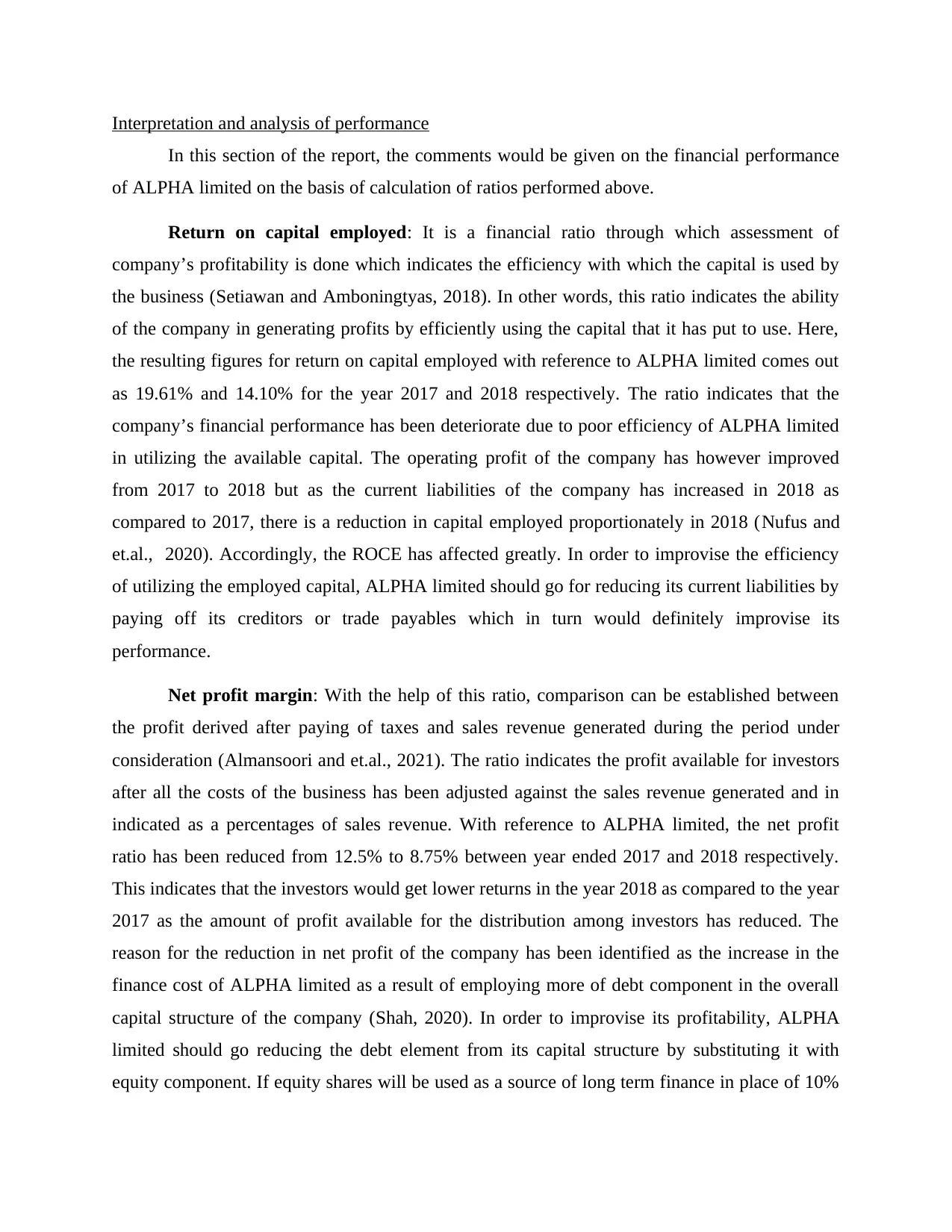
Interpretation and analysis of performance
In this section of the report, the comments would be given on the financial performance
of ALPHA limited on the basis of calculation of ratios performed above.
Return on capital employed: It is a financial ratio through which assessment of
company’s profitability is done which indicates the efficiency with which the capital is used by
the business (Setiawan and Amboningtyas, 2018). In other words, this ratio indicates the ability
of the company in generating profits by efficiently using the capital that it has put to use. Here,
the resulting figures for return on capital employed with reference to ALPHA limited comes out
as 19.61% and 14.10% for the year 2017 and 2018 respectively. The ratio indicates that the
company’s financial performance has been deteriorate due to poor efficiency of ALPHA limited
in utilizing the available capital. The operating profit of the company has however improved
from 2017 to 2018 but as the current liabilities of the company has increased in 2018 as
compared to 2017, there is a reduction in capital employed proportionately in 2018 (Nufus and
et.al., 2020). Accordingly, the ROCE has affected greatly. In order to improvise the efficiency
of utilizing the employed capital, ALPHA limited should go for reducing its current liabilities by
paying off its creditors or trade payables which in turn would definitely improvise its
performance.
Net profit margin: With the help of this ratio, comparison can be established between
the profit derived after paying of taxes and sales revenue generated during the period under
consideration (Almansoori and et.al., 2021). The ratio indicates the profit available for investors
after all the costs of the business has been adjusted against the sales revenue generated and in
indicated as a percentages of sales revenue. With reference to ALPHA limited, the net profit
ratio has been reduced from 12.5% to 8.75% between year ended 2017 and 2018 respectively.
This indicates that the investors would get lower returns in the year 2018 as compared to the year
2017 as the amount of profit available for the distribution among investors has reduced. The
reason for the reduction in net profit of the company has been identified as the increase in the
finance cost of ALPHA limited as a result of employing more of debt component in the overall
capital structure of the company (Shah, 2020). In order to improvise its profitability, ALPHA
limited should go reducing the debt element from its capital structure by substituting it with
equity component. If equity shares will be used as a source of long term finance in place of 10%
In this section of the report, the comments would be given on the financial performance
of ALPHA limited on the basis of calculation of ratios performed above.
Return on capital employed: It is a financial ratio through which assessment of
company’s profitability is done which indicates the efficiency with which the capital is used by
the business (Setiawan and Amboningtyas, 2018). In other words, this ratio indicates the ability
of the company in generating profits by efficiently using the capital that it has put to use. Here,
the resulting figures for return on capital employed with reference to ALPHA limited comes out
as 19.61% and 14.10% for the year 2017 and 2018 respectively. The ratio indicates that the
company’s financial performance has been deteriorate due to poor efficiency of ALPHA limited
in utilizing the available capital. The operating profit of the company has however improved
from 2017 to 2018 but as the current liabilities of the company has increased in 2018 as
compared to 2017, there is a reduction in capital employed proportionately in 2018 (Nufus and
et.al., 2020). Accordingly, the ROCE has affected greatly. In order to improvise the efficiency
of utilizing the employed capital, ALPHA limited should go for reducing its current liabilities by
paying off its creditors or trade payables which in turn would definitely improvise its
performance.
Net profit margin: With the help of this ratio, comparison can be established between
the profit derived after paying of taxes and sales revenue generated during the period under
consideration (Almansoori and et.al., 2021). The ratio indicates the profit available for investors
after all the costs of the business has been adjusted against the sales revenue generated and in
indicated as a percentages of sales revenue. With reference to ALPHA limited, the net profit
ratio has been reduced from 12.5% to 8.75% between year ended 2017 and 2018 respectively.
This indicates that the investors would get lower returns in the year 2018 as compared to the year
2017 as the amount of profit available for the distribution among investors has reduced. The
reason for the reduction in net profit of the company has been identified as the increase in the
finance cost of ALPHA limited as a result of employing more of debt component in the overall
capital structure of the company (Shah, 2020). In order to improvise its profitability, ALPHA
limited should go reducing the debt element from its capital structure by substituting it with
equity component. If equity shares will be used as a source of long term finance in place of 10%
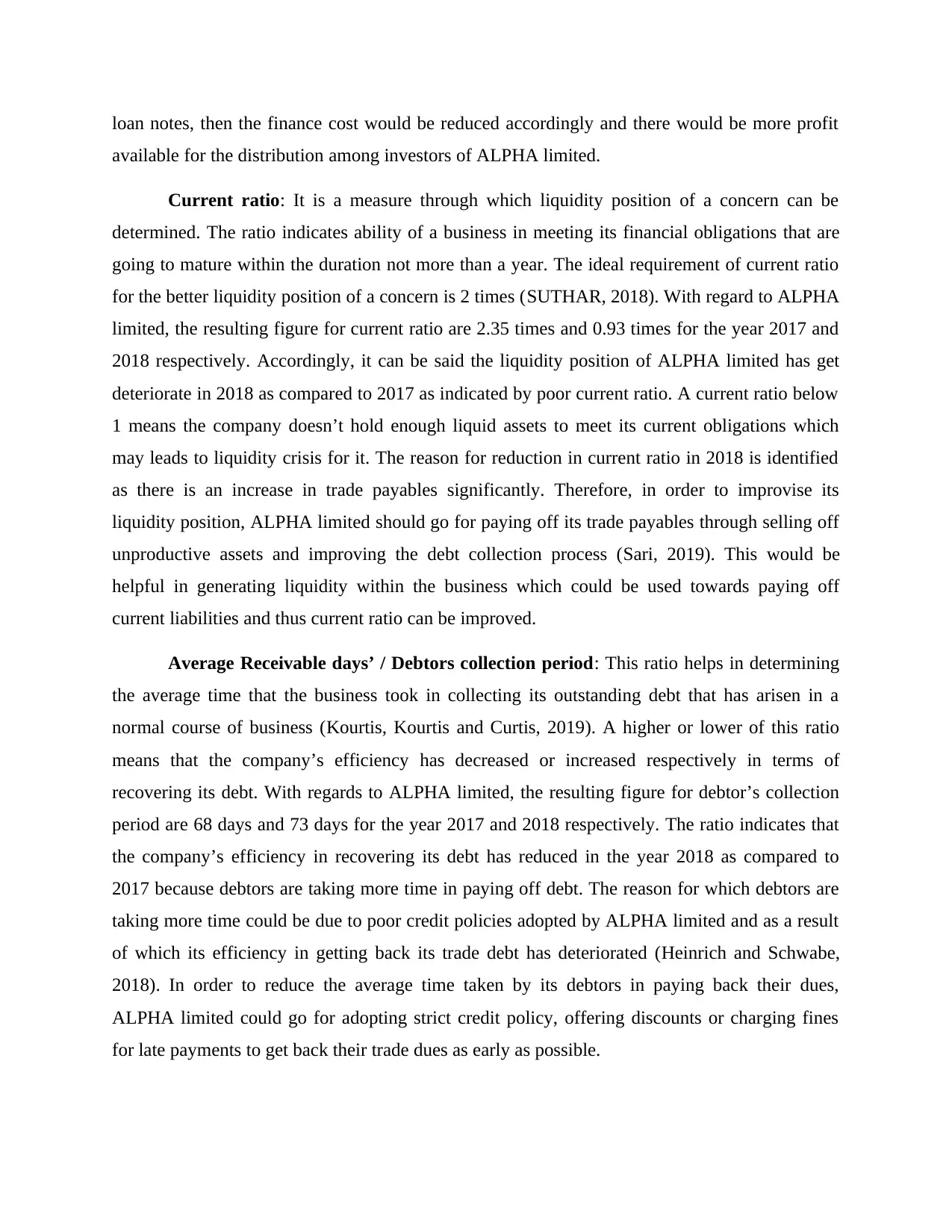
loan notes, then the finance cost would be reduced accordingly and there would be more profit
available for the distribution among investors of ALPHA limited.
Current ratio: It is a measure through which liquidity position of a concern can be
determined. The ratio indicates ability of a business in meeting its financial obligations that are
going to mature within the duration not more than a year. The ideal requirement of current ratio
for the better liquidity position of a concern is 2 times (SUTHAR, 2018). With regard to ALPHA
limited, the resulting figure for current ratio are 2.35 times and 0.93 times for the year 2017 and
2018 respectively. Accordingly, it can be said the liquidity position of ALPHA limited has get
deteriorate in 2018 as compared to 2017 as indicated by poor current ratio. A current ratio below
1 means the company doesn’t hold enough liquid assets to meet its current obligations which
may leads to liquidity crisis for it. The reason for reduction in current ratio in 2018 is identified
as there is an increase in trade payables significantly. Therefore, in order to improvise its
liquidity position, ALPHA limited should go for paying off its trade payables through selling off
unproductive assets and improving the debt collection process (Sari, 2019). This would be
helpful in generating liquidity within the business which could be used towards paying off
current liabilities and thus current ratio can be improved.
Average Receivable days’ / Debtors collection period: This ratio helps in determining
the average time that the business took in collecting its outstanding debt that has arisen in a
normal course of business (Kourtis, Kourtis and Curtis, 2019). A higher or lower of this ratio
means that the company’s efficiency has decreased or increased respectively in terms of
recovering its debt. With regards to ALPHA limited, the resulting figure for debtor’s collection
period are 68 days and 73 days for the year 2017 and 2018 respectively. The ratio indicates that
the company’s efficiency in recovering its debt has reduced in the year 2018 as compared to
2017 because debtors are taking more time in paying off debt. The reason for which debtors are
taking more time could be due to poor credit policies adopted by ALPHA limited and as a result
of which its efficiency in getting back its trade debt has deteriorated (Heinrich and Schwabe,
2018). In order to reduce the average time taken by its debtors in paying back their dues,
ALPHA limited could go for adopting strict credit policy, offering discounts or charging fines
for late payments to get back their trade dues as early as possible.
available for the distribution among investors of ALPHA limited.
Current ratio: It is a measure through which liquidity position of a concern can be
determined. The ratio indicates ability of a business in meeting its financial obligations that are
going to mature within the duration not more than a year. The ideal requirement of current ratio
for the better liquidity position of a concern is 2 times (SUTHAR, 2018). With regard to ALPHA
limited, the resulting figure for current ratio are 2.35 times and 0.93 times for the year 2017 and
2018 respectively. Accordingly, it can be said the liquidity position of ALPHA limited has get
deteriorate in 2018 as compared to 2017 as indicated by poor current ratio. A current ratio below
1 means the company doesn’t hold enough liquid assets to meet its current obligations which
may leads to liquidity crisis for it. The reason for reduction in current ratio in 2018 is identified
as there is an increase in trade payables significantly. Therefore, in order to improvise its
liquidity position, ALPHA limited should go for paying off its trade payables through selling off
unproductive assets and improving the debt collection process (Sari, 2019). This would be
helpful in generating liquidity within the business which could be used towards paying off
current liabilities and thus current ratio can be improved.
Average Receivable days’ / Debtors collection period: This ratio helps in determining
the average time that the business took in collecting its outstanding debt that has arisen in a
normal course of business (Kourtis, Kourtis and Curtis, 2019). A higher or lower of this ratio
means that the company’s efficiency has decreased or increased respectively in terms of
recovering its debt. With regards to ALPHA limited, the resulting figure for debtor’s collection
period are 68 days and 73 days for the year 2017 and 2018 respectively. The ratio indicates that
the company’s efficiency in recovering its debt has reduced in the year 2018 as compared to
2017 because debtors are taking more time in paying off debt. The reason for which debtors are
taking more time could be due to poor credit policies adopted by ALPHA limited and as a result
of which its efficiency in getting back its trade debt has deteriorated (Heinrich and Schwabe,
2018). In order to reduce the average time taken by its debtors in paying back their dues,
ALPHA limited could go for adopting strict credit policy, offering discounts or charging fines
for late payments to get back their trade dues as early as possible.
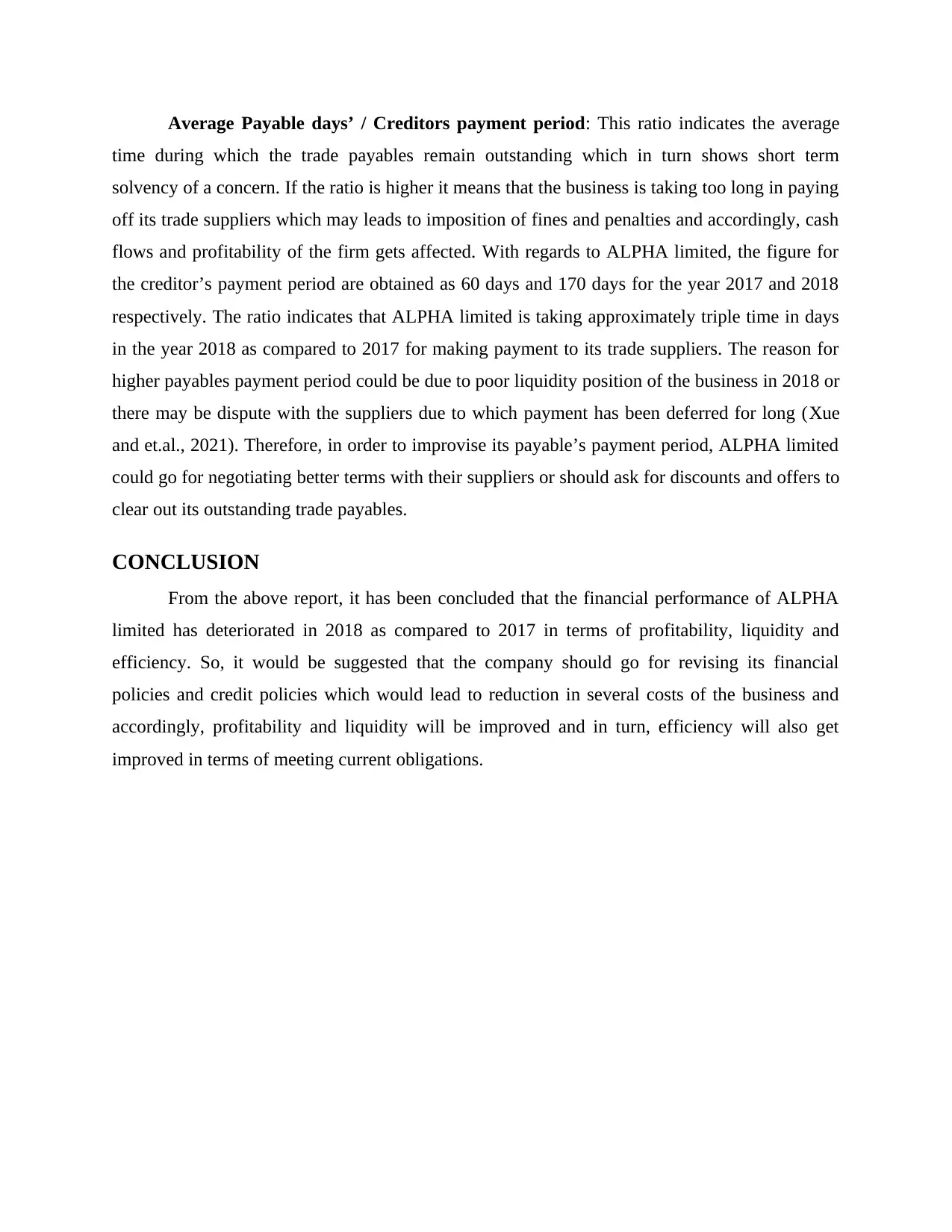
Average Payable days’ / Creditors payment period: This ratio indicates the average
time during which the trade payables remain outstanding which in turn shows short term
solvency of a concern. If the ratio is higher it means that the business is taking too long in paying
off its trade suppliers which may leads to imposition of fines and penalties and accordingly, cash
flows and profitability of the firm gets affected. With regards to ALPHA limited, the figure for
the creditor’s payment period are obtained as 60 days and 170 days for the year 2017 and 2018
respectively. The ratio indicates that ALPHA limited is taking approximately triple time in days
in the year 2018 as compared to 2017 for making payment to its trade suppliers. The reason for
higher payables payment period could be due to poor liquidity position of the business in 2018 or
there may be dispute with the suppliers due to which payment has been deferred for long (Xue
and et.al., 2021). Therefore, in order to improvise its payable’s payment period, ALPHA limited
could go for negotiating better terms with their suppliers or should ask for discounts and offers to
clear out its outstanding trade payables.
CONCLUSION
From the above report, it has been concluded that the financial performance of ALPHA
limited has deteriorated in 2018 as compared to 2017 in terms of profitability, liquidity and
efficiency. So, it would be suggested that the company should go for revising its financial
policies and credit policies which would lead to reduction in several costs of the business and
accordingly, profitability and liquidity will be improved and in turn, efficiency will also get
improved in terms of meeting current obligations.
time during which the trade payables remain outstanding which in turn shows short term
solvency of a concern. If the ratio is higher it means that the business is taking too long in paying
off its trade suppliers which may leads to imposition of fines and penalties and accordingly, cash
flows and profitability of the firm gets affected. With regards to ALPHA limited, the figure for
the creditor’s payment period are obtained as 60 days and 170 days for the year 2017 and 2018
respectively. The ratio indicates that ALPHA limited is taking approximately triple time in days
in the year 2018 as compared to 2017 for making payment to its trade suppliers. The reason for
higher payables payment period could be due to poor liquidity position of the business in 2018 or
there may be dispute with the suppliers due to which payment has been deferred for long (Xue
and et.al., 2021). Therefore, in order to improvise its payable’s payment period, ALPHA limited
could go for negotiating better terms with their suppliers or should ask for discounts and offers to
clear out its outstanding trade payables.
CONCLUSION
From the above report, it has been concluded that the financial performance of ALPHA
limited has deteriorated in 2018 as compared to 2017 in terms of profitability, liquidity and
efficiency. So, it would be suggested that the company should go for revising its financial
policies and credit policies which would lead to reduction in several costs of the business and
accordingly, profitability and liquidity will be improved and in turn, efficiency will also get
improved in terms of meeting current obligations.
Paraphrase This Document
Need a fresh take? Get an instant paraphrase of this document with our AI Paraphraser
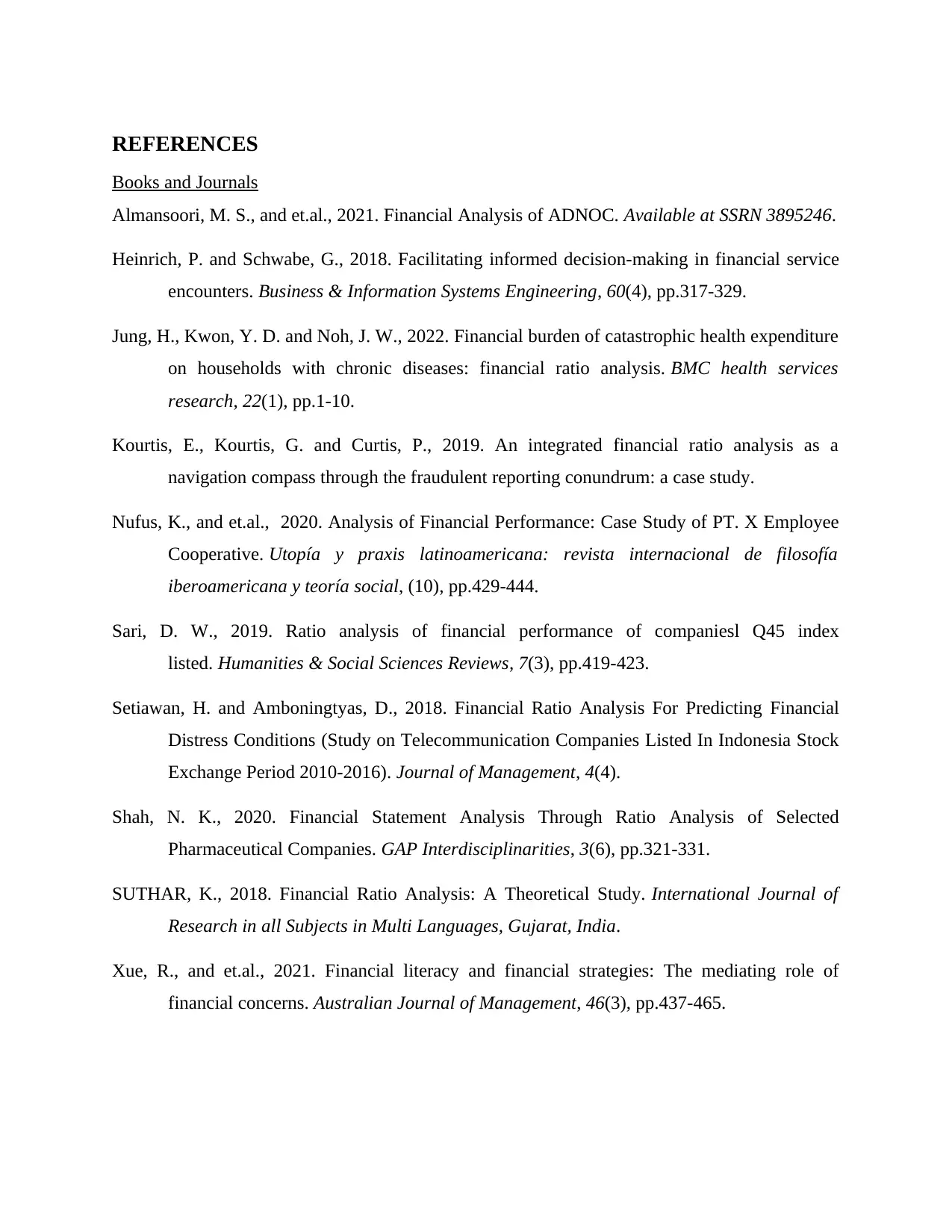
REFERENCES
Books and Journals
Almansoori, M. S., and et.al., 2021. Financial Analysis of ADNOC. Available at SSRN 3895246.
Heinrich, P. and Schwabe, G., 2018. Facilitating informed decision-making in financial service
encounters. Business & Information Systems Engineering, 60(4), pp.317-329.
Jung, H., Kwon, Y. D. and Noh, J. W., 2022. Financial burden of catastrophic health expenditure
on households with chronic diseases: financial ratio analysis. BMC health services
research, 22(1), pp.1-10.
Kourtis, E., Kourtis, G. and Curtis, P., 2019. An integrated financial ratio analysis as a
navigation compass through the fraudulent reporting conundrum: a case study.
Nufus, K., and et.al., 2020. Analysis of Financial Performance: Case Study of PT. X Employee
Cooperative. Utopía y praxis latinoamericana: revista internacional de filosofía
iberoamericana y teoría social, (10), pp.429-444.
Sari, D. W., 2019. Ratio analysis of financial performance of companiesl Q45 index
listed. Humanities & Social Sciences Reviews, 7(3), pp.419-423.
Setiawan, H. and Amboningtyas, D., 2018. Financial Ratio Analysis For Predicting Financial
Distress Conditions (Study on Telecommunication Companies Listed In Indonesia Stock
Exchange Period 2010-2016). Journal of Management, 4(4).
Shah, N. K., 2020. Financial Statement Analysis Through Ratio Analysis of Selected
Pharmaceutical Companies. GAP Interdisciplinarities, 3(6), pp.321-331.
SUTHAR, K., 2018. Financial Ratio Analysis: A Theoretical Study. International Journal of
Research in all Subjects in Multi Languages, Gujarat, India.
Xue, R., and et.al., 2021. Financial literacy and financial strategies: The mediating role of
financial concerns. Australian Journal of Management, 46(3), pp.437-465.
Books and Journals
Almansoori, M. S., and et.al., 2021. Financial Analysis of ADNOC. Available at SSRN 3895246.
Heinrich, P. and Schwabe, G., 2018. Facilitating informed decision-making in financial service
encounters. Business & Information Systems Engineering, 60(4), pp.317-329.
Jung, H., Kwon, Y. D. and Noh, J. W., 2022. Financial burden of catastrophic health expenditure
on households with chronic diseases: financial ratio analysis. BMC health services
research, 22(1), pp.1-10.
Kourtis, E., Kourtis, G. and Curtis, P., 2019. An integrated financial ratio analysis as a
navigation compass through the fraudulent reporting conundrum: a case study.
Nufus, K., and et.al., 2020. Analysis of Financial Performance: Case Study of PT. X Employee
Cooperative. Utopía y praxis latinoamericana: revista internacional de filosofía
iberoamericana y teoría social, (10), pp.429-444.
Sari, D. W., 2019. Ratio analysis of financial performance of companiesl Q45 index
listed. Humanities & Social Sciences Reviews, 7(3), pp.419-423.
Setiawan, H. and Amboningtyas, D., 2018. Financial Ratio Analysis For Predicting Financial
Distress Conditions (Study on Telecommunication Companies Listed In Indonesia Stock
Exchange Period 2010-2016). Journal of Management, 4(4).
Shah, N. K., 2020. Financial Statement Analysis Through Ratio Analysis of Selected
Pharmaceutical Companies. GAP Interdisciplinarities, 3(6), pp.321-331.
SUTHAR, K., 2018. Financial Ratio Analysis: A Theoretical Study. International Journal of
Research in all Subjects in Multi Languages, Gujarat, India.
Xue, R., and et.al., 2021. Financial literacy and financial strategies: The mediating role of
financial concerns. Australian Journal of Management, 46(3), pp.437-465.
1 out of 8
Related Documents
Your All-in-One AI-Powered Toolkit for Academic Success.
+13062052269
info@desklib.com
Available 24*7 on WhatsApp / Email
![[object Object]](/_next/static/media/star-bottom.7253800d.svg)
Unlock your academic potential
© 2024 | Zucol Services PVT LTD | All rights reserved.




